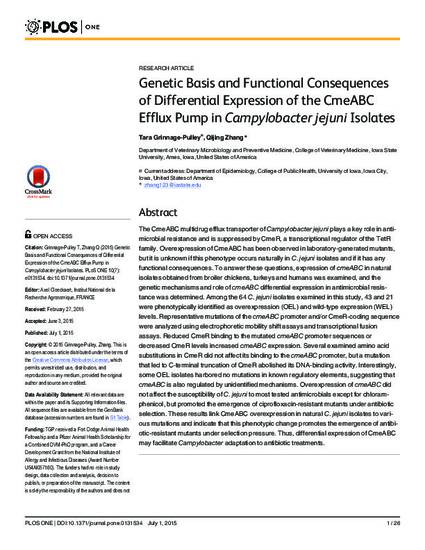
Article
Genetic Basis and Functional Consequences of Differential Expression of the CmeABC Efflux Pump in Campylobacter jejuni Isolates
PLoS ONE
Document Type
Article
Disciplines
Publication Version
Published Version
Publication Date
7-1-2015
DOI
10.1371/journal.pone.0131534
Abstract
The CmeABC multidrug efflux transporter of Campylobacter jejuni plays a key role in antimicrobial resistance and is suppressed by CmeR, a transcriptional regulator of the TetR family. Overexpression of CmeABC has been observed in laboratory-generated mutants, but it is unknown if this phenotype occurs naturally in C. jejuni isolates and if it has any functional consequences. To answer these questions, expression of cmeABC in natural isolates obtained from broiler chickens, turkeys and humans was examined, and the genetic mechanisms and role of cmeABC differential expression in antimicrobial resistance was determined. Among the 64 C. jejuni isolates examined in this study, 43 and 21 were phenotypically identified as overexpression (OEL) and wild-type expression (WEL) levels. Representative mutations of thecmeABC promoter and/or CmeR-coding sequence were analyzed using electrophoretic mobility shift assays and transcriptional fusion assays. Reduced CmeR binding to the mutated cmeABCpromoter sequences or decreased CmeR levels increased cmeABC expression. Several examined amino acid substitutions in CmeR did not affect its binding to the cmeABC promoter, but a mutation that led to C-terminal truncation of CmeR abolished its DNA-binding activity. Interestingly, some OEL isolates harbored no mutations in known regulatory elements, suggesting that cmeABC is also regulated by unidentified mechanisms. Overexpression ofcmeABC did not affect the susceptibility of C. jejuni to most tested antimicrobials except for chloramphenicol, but promoted the emergence of ciprofloxacin-resistant mutants under antibiotic selection. These results link CmeABC overexpression in natural C. jejuni isolates to various mutations and indicate that this phenotypic change promotes the emergence of antibiotic-resistant mutants under selection pressure. Thus, differential expression of CmeABC may facilitate Campylobacter adaptation to antibiotic treatments.
Rights
This is an open access article distributed under the terms of the Creative Commons Attribution License, which permits unrestricted use, distribution, and reproduction in any medium, provided the original author and source are credited
Copyright Owner
Grinnage-Pulley, Zhang
Copyright Date
2015
Language
en
File Format
application/pdf
Citation Information
Tara Grinnage-Pulley and Qijing Zhang. "Genetic Basis and Functional Consequences of Differential Expression of the CmeABC Efflux Pump in Campylobacter jejuni Isolates" PLoS ONE Vol. 10 Iss. 7 (2015) p. e0131534 Available at: http://works.bepress.com/qijing-zhang/15/

This article is from PLoS ONE 10 (2015): e0131534, doi:10.1371/journal.pone.0131534. Posted with permission.